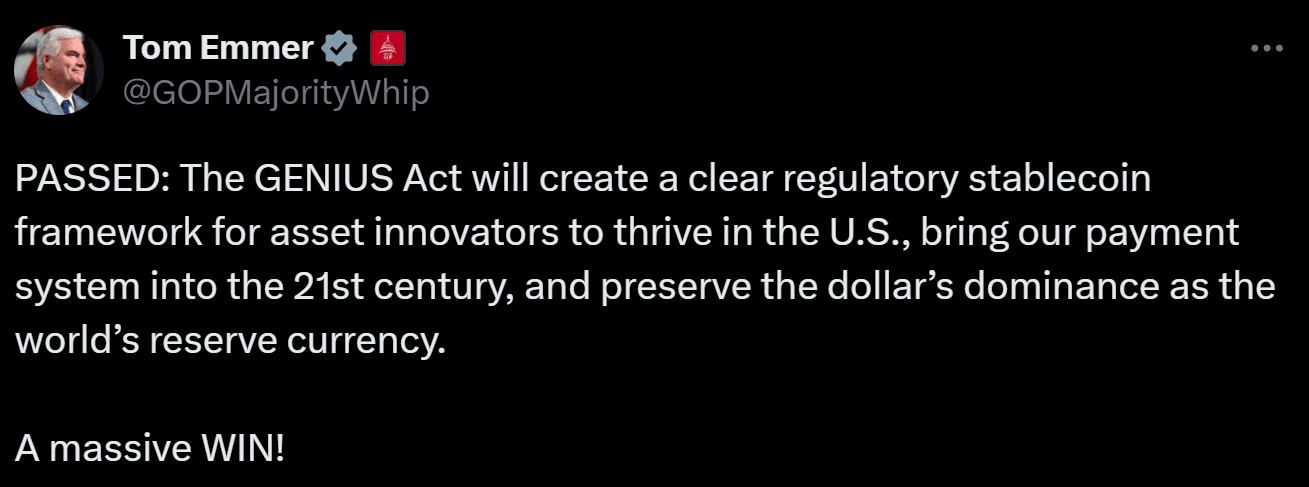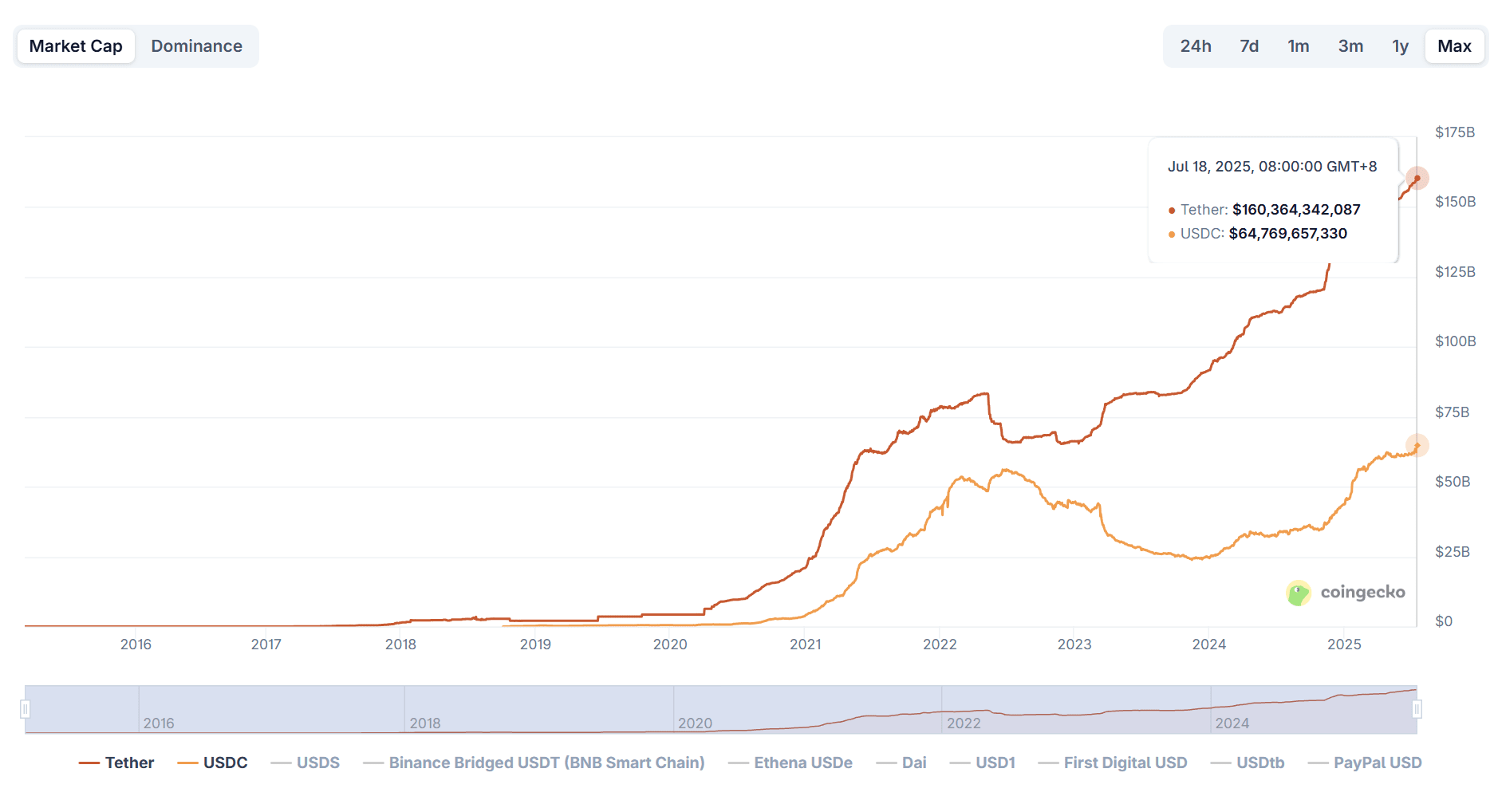Stablecoins in the context of policy expansion are no longer mere narratives.
In the early hours of today Beijing time, the US House of Representatives passed three pieces of crypto-related legislation: (CLARITY Act), (GENIUS Act), and the (Anti-CBDC Surveillance National Act), among which the (GENIUS Act) is expected to be signed into law by Trump on Friday local time.

This not only marks the first time the US has established a national-level regulatory framework for stablecoins but also releases a clear signal that stablecoins are moving out of the gray area and into the marginal space of the mainstream financial system. At the same time, major financial centers such as Hong Kong and the EU are also quickening their steps, and the global stablecoin landscape is undergoing a reshaping.
Looking back over the past few months, we find that stablecoins have almost overnight transformed from a financial variable under regulatory scrutiny into a new infrastructure recognized by the authorities. What has happened behind this, who is pushing stablecoins to become the new protagonist on the global financial stage? How should we rationally understand this wave?
From Web3 narrative to national strategy, who is driving this?
Since the beginning of the year, stablecoins have undoubtedly risen to become the focus of global financial policy and narrative.
However, this wave is neither coincidental nor a product of natural technological evolution, but a structural shift driven by policy forces, especially the policy shift during the Trump era, which has played a disruptive 'catfish role.'
On one hand, Trump has always clearly opposed central bank digital currencies (CBDC) and has explicitly supported a market-driven digital dollar route; on the other hand, from endorsing the family business's launch of USD1 to promoting and soon signing the GENIUS Act, Trump is also actively fulfilling his campaign promise to deregulate the crypto market.
This series of signals has also directly forced global regulatory agencies to begin re-evaluating stablecoins. In just a few months, stablecoins have jumped from a marginal issue in the crypto circle to a key discussion point at the national strategic level. Apart from Hong Kong finalizing the timeline for its (Stablecoin Regulation), major economies around the world have also begun to seriously consider and accelerate the establishment of clear compliance frameworks for stablecoins.
The EU's (MiCA regulation) (Markets in Crypto-Assets), which will take effect in 2024, has comprehensively covered the compliance regulation of crypto assets and has detailed classifications for stablecoins.
The ruling party of South Korea's new president, Lee Jae-myung, has proposed the (Basic Law on Digital Assets), clearly stating that as long as a South Korean company has a capital of at least 500 million won (approximately 370,000 USD) and ensures refunds through reserves, it can issue stablecoins.
Objectively speaking, the passing of the GENIUS Act is not just the US loosening restrictions on stablecoins but is also a clear choice for the digital dollar route—abandoning central bank digital currency (CBDC) while supporting compliant, privately issued dollar stablecoins.
It is foreseeable that the US's statement will become a reference paradigm for regulatory designs in other countries, pushing stablecoins into the common discussion framework of global financial policy.
The path of stablecoins is changing.
In recent years, the stablecoin market has long been dominated by Tether (USDT) and Circle (USDC), representing the paths of 'circulation efficiency' and 'compliance transparency' respectively:
USDT focuses on cross-platform circulation and matching efficiency, dominating in exchanges and gray settlement networks;
USDC emphasizes asset compliance and transparency, deeply cultivating regulatory-friendly scenarios and institutional client systems;
From an overall scale perspective, since 2025, stablecoins have still maintained a growth trend—according to CoinGecko data, as of July 18, the total market cap of stablecoins across the network was approximately 262 billion USD, representing a growth of over 20% compared to the beginning of the year.

This also means that in the process of the crypto market warming up, stablecoins remain the core 'liquidity entrance,' and the dual oligopoly pattern of USDT and USDC remains solid—USDT's total market cap exceeds 160 billion USD, accounting for over 60%; USDC remains around 65 billion USD, accounting for about 25%, with both together accounting for nearly 90% of the market share.
Starting in 2024, more and more Web2 financial enterprises and traditional capital forces are beginning to enter the market, using stablecoins to build on-chain settlement tools. For example, PayPal's PYUSD and the newly politically capital-backed USD1 are two representative signals of this trend.
PYUSD (PayPal USD) launched by the payment giant PayPal naturally possesses cross-border settlement scenarios and a global merchant network; USD1 aims for on-chain compliant inflow and outflow and cross-border business, receiving political and business resource support endorsed by Trump, cutting into enterprise settlement scenarios.
It can be said that with the support of institutions and national power, these emerging stablecoin projects are pushing the function of stablecoins from 'Web3 liquidity tools' to becoming a value bridge connecting Web3 and the real economic system. Their use cases are gradually penetrating into diverse scenarios such as supply chain finance, cross-border trade, freelancer settlements, OTC scenarios, and more.
Behind the frenzy, what is the real challenge for stablecoins?
However, objectively speaking, while the GENIUS Act has given stablecoins institutional recognition, it has also brought more compliance requirements, setting clearer rules for their development.
For example, the issuing entity must accept KYC/AML management, funds must have custodial isolation and third-party auditing, and in extreme situations, issuance limits or usage restrictions may be set, etc. This means that stablecoins have gained legal status, but have also officially entered the role of 'regulated currency.'
From this perspective, whether stablecoins can break through the application limitations of Web3 is key to their incremental landing. After all, looking further, the greatest growth potential of stablecoins lies not within the Crypto internal circle but in the broader Web2 and the global real economy.
Just like the main increment of USDT and USDC, which no longer comes from on-chain interactive users but from SMEs and individual merchants with a strong demand for cross-border settlements, emerging markets and financially disadvantaged areas unable to access the SWIFT network, residents of inflationary countries seeking to escape currency fluctuations, and content creators and freelancers unable to use PayPal, Stripe, etc.
In other words, its greatest future increment lies not in Web3, but in Web2—the truly killer application for stablecoins is not 'the next DeFi protocol,' but 'replacing traditional dollar accounts.'
This also means that once stablecoins become the foundational carrier of digital dollars globally, it will inevitably touch sensitive nerves such as currency sovereignty, financial sanctions, and geopolitical order.
Therefore, the next stage of growth for stablecoins will inevitably be closely related to the new map of US dollar globalization and will become a new battlefield among governments, international institutions, and financial giants.
In conclusion
The essence of currency issuance has always been an extension of power, relying not only on asset reserves and clearing efficiency but also on national credit, regulatory permits, and international endorsements.
Stablecoins are no exception. If they want to truly penetrate the real economic system from the Crypto world, relying solely on market mechanisms or business logic is ultimately insufficient. Therefore, the compliance support brought about by the global policy shift in 2025 is undoubtedly an important driver for stablecoins to move towards the mainstream, but it also means they must survive in a more complex game.
This is a long-cycle game, and we are at the stage where it truly begins.
#MichaelSaylor暗示增持BTC #币安HODLer空投ERA #特朗普施压鲍威尔
$SOL $XRP $BTC


